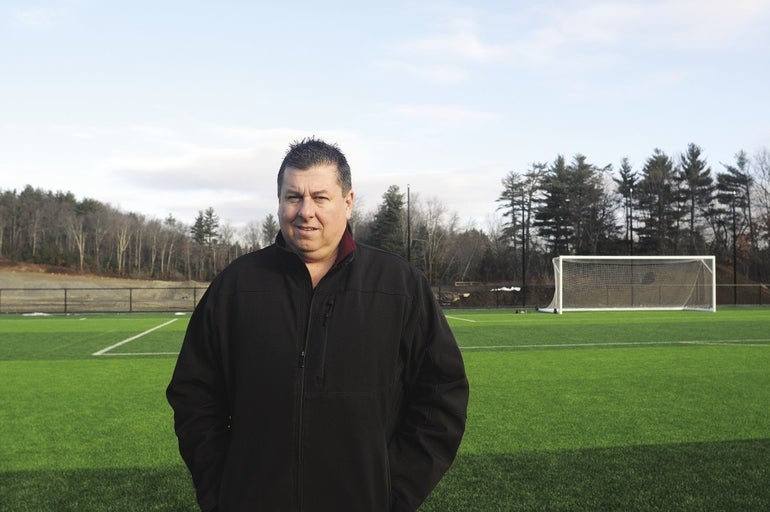Towns aiming to loosen strings to boost business
 PHOTO/SAM BONACCI
Steve Boucher, of Boucher Construction in Leominster, says creation of an overlay district in north Lancaster has helped bring a sports complex and other developments to town.
PHOTO/SAM BONACCI
Steve Boucher, of Boucher Construction in Leominster, says creation of an overlay district in north Lancaster has helped bring a sports complex and other developments to town.
As businesses continue to move into the large stock of vacant commercial buildings along Interstate 495, some communities are looking to boost ground-up development with clear zoning regulations, streamlined permitting processes and infrastructure improvements.
Throughout Worcester and Middlesex counties, commercial vacancy rates hover at around 20 percent or higher, according to data from Colliers International. And vacancies in large office and research complexes have led to substantial moves in the last year by companies, such as GE Healthcare Life Sciences' pending move into Marlborough.
Existing commercial properties offer a quick transition for companies needing only interior retrofitting. But for many of the communities that do not have these large properties, efforts to boost construction are underway.
“It's a matter of even making the (approval) process more streamlined, which helps attract developers as well as (identify) areas that need to be rezoned,” said Chantell Fleck, a regional planner for the Fitchburg-based Montachusett Regional Planning Commission (MRPC).
Lancaster, with a population of about 8,000, is one of those communities. Since it completed a master plan in 2007, the town has plunged into efforts to re-zone and streamline its development process to encourage construction, said Noreen Piazza, the town's planning director.
“The zoning has got to be right, the permitting process has got to be easy and relatively quick,” and there must be good access and infrastructure, as well as a single property tax rate, she said. “Those are the biggies.”
In 2009, Lancaster created an overlay district that allows a mixed-use approach to development over the existing zoning on the north side of town. More recently, in 2013, three commercial, industrial and office districts were consolidated into one enterprise district, expanding development options along a previously segregated 1.5-mile stretch of Route 2.
Other towns are undertaking similar efforts, Fleck said. The MRPC represents 29 communities in northern Worcester County, and municipalities such as Fitchburg and Leominster are reviewing their zoning and permitting processes.
Any town that wants to encourage development “needs to take a look at their existing land uses and what is available,” she said. “It's really (a matter of) taking an overall, hard look.”
Many towns have not revisited their zoning since the 1970s, Fleck said, which can leave them at a disadvantage as developers seek to create integrated, walkable communities, which are enjoying a revival among businesses and residents. “It's a throwback to what originally was done for land use in a lot of our New England towns,” Fleck said. “A lot of the towns we have been working with are going back to those mixed-use, village concepts.”
Opening up industrial areas to more uses is especially conducive to redevelopment, she said.
Helped by zoning …
Lancaster's zoning changes have made a difference for Steve Boucher, of Boucher Construction in Leominster, which owns more than 350 acres of land in the north Lancaster overlay district. Developments on the property include a sports complex with two turf fields, a transportation company and an Agway retail store. The property's location via major access roads of Route 2 and Interstate 190 set it up for success, but the zoning has been a major influence.
Boucher said he's in talks with companies to build housing and retail, a sports medicine center and an additional sports complex. (He declined to name the companies because of ongoing negotiations.) Yet, none of this would have been possible before the overlay district was added, Boucher said.
“They do have an eye on this area for development, tax revenue and building,” he said. “There are other towns that can do expedited permitting, but this town has spent so much time crafting the zoning.”
The town is also focused on improvements such as road upgrades and installing sewer and water infrastructure to the area, Piazza explained. This push toward development spills over into a smoother permitting process, Boucher said.
“That's (a developer's) first question. … 'How long will it take to permit and it is in the expedited zone?' ” he said. “If they go to another town and it can be done in two months or three months and they come to a town that has historically dragged on permitting … they will go to another site.”
... and easier permitting
The ease of permitting can be as important as improving zoning to allow for a more flexible use of the property, according to developers. There are some communities where either town boards, officials or citizen groups have a reputation for slowing development, said Gilbert Winn, managing principal of Winn Development, of Boston. This can work for developers favored by these groups, but other developers will avoid those communities.
“If you had a unique opportunity in a city that is very tough on regulations and permits, but you happen to control a building or site you know is a priority, then (that) is the best city to do business in,” he said. “In the development community, there are cities you just wouldn't do business in unless it is a unique opportunity.”
But attracting developers is not just limited to smaller towns, said Don Mancini, principal at Worcester brokerage Kelleher & Sadowsky, who explained that Worcester lacks extremely large commercial stock compared with such communities as Marlborough.
But Worcester is attempting to take an active role in modifying zoning to attract developers, according to Planning Director Stephen Rolle. The city is exploring a commercial corridors overlay district that Rolle said would ease development restrictions in the downtown area and encourage mixed use.
“I think it's important to think of the zoning ordinances as a living document that needs to be (evaluated) and reflect best practices,” he said. “The world is a changing place and you can't just leave zoning alone for 20 years.”









0 Comments